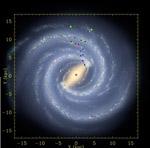
Over the next five years, Mark Reid and an international team of scientists will use the Very Long Baseline Array (VLBA) to map the spiral structure of the Milky Way. Using methanol and water masers associated with young massive stars, the team plans to measure the trigonometric parallaxes and proper motions of nearly 400 star forming regions. The accurate distances derived from the parallaxes will enable high quality maps of the spiral arms; the proper motions will yield the three-dimensional space motions of massive stars throughout the Galaxy.
The VLBA is a system of ten radio-telescope antennas deployed across the northern half of the western hemisphere. Each telescope is a dish 25 meters (82 feet) in diameter. This project is the largest ever undertaken by the VLBA. Achieving the planned goals will require 5280 hours of telescope time over the next five years. Combined with extensive data analysis tools, the data from this project will yield parallaxes with ~10 micro-arcsecond accuracy (+- 10% distance at 10 kpc) and proper motions with ~20 micro-arcseconds/year accuracy (+- 1 km/s).
Additional information is available here: